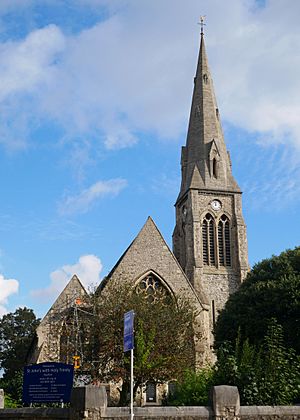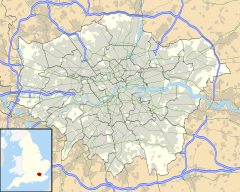St Johns, London facts for kids
Quick facts for kids St Johns |
|
|---|---|
 St John's Church |
|
| OS grid reference | TQ373764 |
| London borough | |
| Ceremonial county | Greater London |
| Region | |
| Country | England |
| Sovereign state | United Kingdom |
| Post town | LONDON |
| Postcode district | SE8 |
| Dialling code | 020 |
| Police | Metropolitan |
| Fire | London |
| Ambulance | London |
| EU Parliament | London |
| UK Parliament |
|
| London Assembly |
|
St Johns is a lively area in south-east London. It's named after its train station, St Johns station. This district is part of the London Borough of Lewisham, right next to the Royal Borough of Greenwich. It forms the north-western part of Lewisham, along with Telegraph Hill.
St Johns is famous for its beautiful 19th-century houses. These homes were built as part of 'Deptford New Town'. They are now protected areas, called Conservation Areas, to keep their special look. In 1957, St Johns was also the site of one of Britain's worst railway accidents.
Contents
What's in a Name?
The name St Johns comes from the Church of England parish church of St John, Deptford. This church was built in 1855. It stands at the top of a hill, very close to the train station. The station then borrowed its name from the church.
The St Johns area includes streets between Brookmill Road and Lewisham Way. It stretches from Friendly Street in the west to the railway lines in the south-east. Some parts of northern Brockley are also often considered part of St Johns. This includes the popular Brockley Farmers' Market.
A Look Back in Time
The idea for 'Deptford New Town' came from the Lucas family. They wanted to build affordable and spacious homes. These houses were for working-class people in Deptford during the mid to late 1800s. The Lucas family originally came from Cumbria in England. They made their money in South Carolina, where they ran rice mills powered by water.
There are a few older buildings in St Johns. The most famous is the Stone House. This large house was built in the late 1700s and has an Italian-style design. St John's Church was built in 1855. It was designed by an architect named PC Hardwicke.
St John's train station opened in 1871. This was when many new houses were still being built in the area.
Protecting the Area
The Brookmill Road Conservation Area was created in 1972. It helps protect the special character of the houses and streets there. Four years later, the St John's Conservation Area was also set up. These areas help make sure that changes to buildings keep the original style.
Who Lives Here?
The people living in St Johns are a mix of different backgrounds. This is partly because house prices have gone up a lot recently. Some houses are owned by the local council, some are rented out, and most are owned by the people who live in them.
When the Docklands Light Railway (DLR) arrived nearby, house prices in St Johns went up very quickly. This meant that wealthy people who work in places like Canary Wharf moved in. But many people who had lived in the area for a long time also stayed. This creates a unique mix of residents. The growth of Brockley Farmers' Market, near St Johns station, shows how the area is changing.
The 1957 Train Crash
A Tragic Day
At 6:20 PM on Wednesday, December 4, 1957, a terrible accident happened. Two trains crashed at St Johns station in very thick fog. This crash killed 90 people and injured 176 more. It is still one of Britain's worst railway disasters.
Because of the bad weather, trains were running late and were very crowded. A train from Charing Cross to Hayes was stopped under a railway bridge. This train had 1,500 passengers on board. Then, a steam train from Cannon Street to Ramsgate, carrying 700 people, crashed into the back of the stopped train. It was going about 30 miles per hour.
The Impact
The electric train in front was badly damaged. One carriage was completely crushed by the one behind it. The front carriage of the steam train also crashed into its own engine. This pushed both off the tracks and knocked down a support column for the bridge above. The bridge immediately fell, crushing parts of the trains below.
Another disaster was avoided just two minutes later. A train driver on the elevated section saw the bridge was tilted. He quickly stopped his train. If he hadn't, his train would have fallen onto the wreckage below.
Finding Out What Happened
An official report was written about the crash in 1958. It gave many details and diagrams of where the train carriages ended up. It also had pictures of the collapsed bridge. The report said that Driver W. J. Trew of the steam express train was responsible for the accident.
The report also noted how unlucky it was that the bridge supports were knocked out. The bridge crossed the tracks at a sharp angle. This meant it needed a very long section without support. This design problem was later considered in how new bridges are built.
What's Next for St Johns?
St Johns is a compact area that is well-protected. This means it won't have too much new building. However, it is surrounded by very different areas.
To the north is Greenwich, which is growing quickly. New, expensive houses are being built there. Greenwich is a popular place for tourists, with lots of entertainment and restaurants. To the east is Blackheath. This is a very pretty and sought-after area.
To the south is Lewisham. Lewisham has a big shopping centre and is a major hub for public transport. To the north is Deptford. This is an older, lively area. BBC News even called one of its streets London's best shopping street!
Getting Around
St Johns station is in London Travel Zone 2. It has train services to London Cannon Street (via London Bridge). Trains also go in the other direction to various places in South East London and Kent.
Many Transport for London bus services also serve St Johns. These buses connect the area to places in South and Central London. This includes Lewisham, Greenwich, New Cross, Peckham, Woolwich, Thamesmead, Catford, Eltham, Sidcup, Canada Water, London Bridge, and Victoria.


